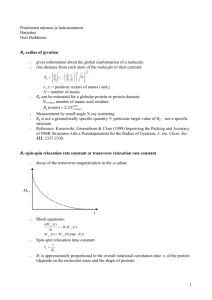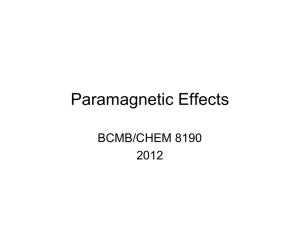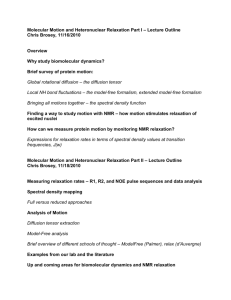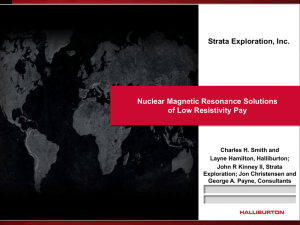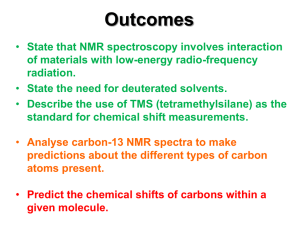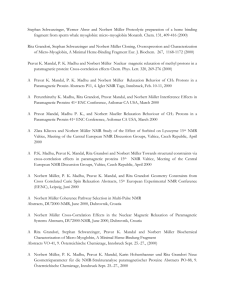Nuclear Magnetic Resonance (NMR) Spectroscopy
advertisement
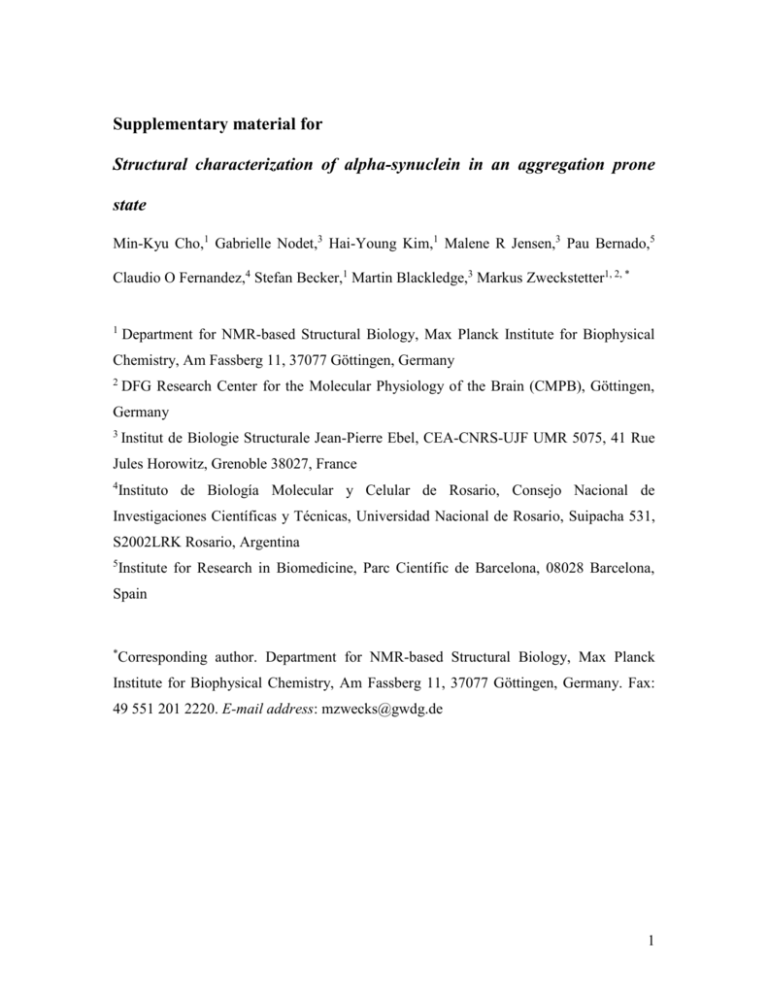
Supplementary material for Structural characterization of alpha-synuclein in an aggregation prone state Min-Kyu Cho,1 Gabrielle Nodet,3 Hai-Young Kim,1 Malene R Jensen,3 Pau Bernado,5 Claudio O Fernandez,4 Stefan Becker,1 Martin Blackledge,3 Markus Zweckstetter1, 2, * 1 Department for NMR-based Structural Biology, Max Planck Institute for Biophysical Chemistry, Am Fassberg 11, 37077 Göttingen, Germany 2 DFG Research Center for the Molecular Physiology of the Brain (CMPB), Göttingen, Germany 3 Institut de Biologie Structurale Jean-Pierre Ebel, CEA-CNRS-UJF UMR 5075, 41 Rue Jules Horowitz, Grenoble 38027, France 4 Instituto de Biología Molecular y Celular de Rosario, Consejo Nacional de Investigaciones Científicas y Técnicas, Universidad Nacional de Rosario, Suipacha 531, S2002LRK Rosario, Argentina 5 Institute for Research in Biomedicine, Parc Científic de Barcelona, 08028 Barcelona, Spain * Corresponding author. Department for NMR-based Structural Biology, Max Planck Institute for Biophysical Chemistry, Am Fassberg 11, 37077 Göttingen, Germany. Fax: 49 551 201 2220. E-mail address: mzwecks@gwdg.de 1 Supplementary Fig. 1. Differences in experimental C chemical shifts observed at pH 3.0 and pH 7.4 as a function of residue number. The largest differences were observed in proximity to Asp and Glu residues. The C difference values are directly calculated form the experimental values without the use of random coil values. 2 V125 V37 V26 Supplementary Fig. 2. Superposition of a selected portion of the 1H-15N HSQC spectra of A18C S in the diamagnetic (blue) and paramagnetic state (red). The cross peak of V26 disappears in the paragmagnetic state. The intensity of the cross peak of V37 decreases, while that of V125 shows a comparable intensity in both conditions. 3 Supplementary materials and methods 1.1. Protein Preparation pT7-7 plasmid encoding for human wt S was kindly provided by the Lansbury Laboratory, Harvard Medical School, Cambridge, MA. Plasmids containing αS variants were expressed in Escherichia coli BL21 (DE3) cells. Protein expression and purification was performed as previously described with minor changes.1 For production of labeled proteins, M9-minimal medium supplemented with Laboratories) was used. For 13 C/15N-labeled samples, 13 15 15 N- NH4Cl (Cambridge Isotope C-Glucose (Cambridge Isotope Laboratories) was also added to the M9-minimal medium. Standard solid-phase peptide synthesis was used to produce a peptide comprising residues 105 to 136 of αS. The peptide was purified by reverse phase HPLC and the purity (>95%) was analyzed by mass spectrometry. NMR samples contained ~ 0.1 mM 15 N- or 15N /13C-labelled S in 20 mM Na acetate, 100 mM NaCl, pH 3.0. 1.2. Spin Labeling of S The nitroxide spin label chosen for reaction with the cysteine-containing mutants was MTSL (1-oxy-2,2,5,5-tetramethyl-D-pyrroline-3-methyl)-methanethiosulfonate (Toronto Research Chemicals, Toronto, Ontario, Canada). MTSL had already proven to efficiently react with S cysteine mutants, and the reaction was carried out as described previously.2 1.3. Alignment of S in Anisotropic Media 4 Residual dipolar couplings (RDCs) were measured for S aligned in 5% w/v noctyl-penta(ethylene glycol)/octanol (C8E5) (Sigma).3 Formation of the anisotropic, dilute liquid crystalline phase was monitored by the splitting of the deuterium signal, which was 18 ± 2 Hz at pH 7.4 and 22.5 ± 2 Hz at pH 3.0. 1.4. NMR Spectroscopy The experiments were recorded on Bruker Avance 600, 700 and 800 MHz NMR spectrometers at 15 C. Data processing was performed using the software packages NMRPipe/NMRDraw,4 Topspin (Bruker) and Sparky.5 A pH titration using twodimensional (2D) 1H-15N Heteronuclear Single Quantum Coherene (HSQC) spectra in combination with three-dimensional triple-resonance experiments (HNCO, HACANNH, HNCACB) was performed, to obtain sequence-specific assignments for the backbone of of S at pH 3.0. Secondary shift values were analyzed using the SSP program.6 Pulsed-field gradient NMR experiments were acquired at 15 °C on unlabeled S (100 M) dissolved in 99.9 % D2O, 100 mM NaCl and containing dioxane (~20 mM) as an internal radius standard and viscosity probe.7 Sixteen one-dimensional 1H spectra were collected as a function of gradient strength varying between 2 % and 95 % of its maximum value. After baseline correction, the decay in the intensity of the signals from the aliphatic region was fitted as a function of gradient strength (g) to the equation f(g) = Ae-d(g^2). J(HNH) scalar couplings were measured using a 2D intensity-modulated 1H-15N 3 HSQC spectrum (48 scans, relaxation delay 1.2 ms, 2τ = time for evolution of 3JHNHα: 30 5 ms).8 Coupling values were calculated from the intensity ratios using the relation Scross/Sdiag = cos(π3JHNHα2τ). One-bond N-H RDCs (DNH) were acquired using the 2D inphase-antiphase HSQC sequence9 under both isotropic and anisotropic conditions. DNH values were calculated as the difference between splittings measured in an aligned sample and those measured in the isotropic phase (RDCs were not corrected for the negative gyromagnetic ratio of 15N). Paramagnetic relaxation enhancement (PRE) effects were measured from the peak intensity ratios between two 2D 15N-1H HSQC spectra with a paramagnetic sample and a diamagnetic sample, respectively. Paramagnetic samples were measured at 100 M MTSL-labeled protein concentration, and diamagnetic experiments were performed with 100 M protein in the presence of 0.5 mM ascorbic acid (Sigma), which reduces MTSL at acidic pH. 15 N longitudinal relaxation rate in rotating frame (R1) and transverse relaxation rate (R2) as well as 15 N heteronuclear NOEs were measured at 600 MHz proton frequency at 288 K. For the heteronuclear NOE experiment, 1H saturation was achieved by the application of 120 1H pulses separated by 5 ms, for 3 s period. Eight time points were collected for both R2 and R1 experiments, and each set included duplicate measurements for estimation of the uncertainty. The delays used were 7.6, 30.4, 76.0, 152.0, 243.2, 304.0, 380.0 and 547.2 ms for R2and 8.0, 48.0, 80.0, 160.0, 240.0, 320.0, 400.0, and 480.0 for R1experiment. Time points that were measured twice are shown in italic. 1.5. Flexible Meccano - Interpetation of Ensemble-Averaged Relaxation Rates 6 Flexible-meccano, an algorithm developed to sample the conformational space available to disordered proteins in terms of explicit ensembles of molecules was used. Unbiased conformational ensembles of 10000 structures were calculated, and effective relaxation rates for each conformer calculated in the presence of the four spin probes. Relaxation rates for each conformer are described using the modelfree formalism introduced for interpretation of 1H-1H dipole-dipole cross relaxation (nOe) interactions,10 and recently adapted to the calculation of paramagnetic relaxation enhancement by Clore et al,11 Radial and angular order parameters were calculated over the positions of all allowed spin-probes. Rotameric sampling propensities derived from ESR and molecular dynamics simulation were used to describe possible positions of the MTSL probe 12. The correlation time for the electron-nuclear interaction τc was set to 4 ns, in agreement with previous studies.13 The average relaxation rate was calculated over all individual backbone confomers. Experimental values for the intrinsic transverse relaxation rates14 were used to account for the diamagnetic contribution to the spin relaxation rate. Sub-ensembles were then selected on the basis of agreement with respect to the experimental data using a genetic algorithm. Simulations indicated that for a molecule of this size with four spin labels, ensembles of 80 structures presented a reasonable description of the conformational behaviour while avoiding over-fitting. A more detailed description of this algorithm is in preparation. The identical procedure was applied for both samples, and contact maps showing a logarithmic comparison between the selected ensemble and the original unbiased ensemble are used to compare the data. For the ensembles of 80 conformations the hydrodynamic radius of each conformation was computed with a modified version of the program HydroPRO15 using 7 an atomic element radius of 3.3 Å to define the volume of the conformation. The bead modelling strategy adopted by HydroPRO has been proven to be efficient to calculate hydrodynamic properties for both rigid and flexible molecules.15, 16 The averaged Rh was obtained as follows: 1 1 1 Rh N i 1,N Rh,i (1) , where N is the number of conformations of the ensemble and Rh,i is the hydrodynamic radius of the conformation i. 8 Supplementary references 1. Hoyer W, Antony T, Cherny D, Heim G, Jovin TM, Subramaniam V. (2002) Dependence of alpha-synuclein aggregate morphology on solution conditions. J Mol Biol 322:383-93. 2. Bertoncini CW, Jung YS, Fernandez CO, Hoyer W, Griesinger C, Jovin TM, Zweckstetter M. (2005) Release of long-range tertiary interactions potentiates aggregation of natively unstructured alpha-synuclein. Proc Natl Acad Sci U S A 102:1430-5. 3. Ruckert M, Otting G. (2000) Alignment of biological macromolecules in novel nonionic liquid crystalline media for NMR experiments. J. Am. Chem. Soc. 122:7793-7797. 4. Delaglio F, Grzesiek S, Vuister GW, Zhu G, Pfeifer J, Bax A. (1995) NMRPipe: a multidimensional spectral processing system based on UNIX pipes. J Biomol NMR 6:277-93. 5. Goddard TD, Kneller DG. University of California, San Francisco. 6. Marsh JA, Singh VK, Jia Z, Forman-Kay JD. (2006) Sensitivity of secondary structure propensities to sequence differences between alpha- and gammasynuclein: implications for fibrillation. Protein Sci 15:2795-804. 7. Wilkins DK, Grimshaw SB, Receveur V, Dobson CM, Jones JA, Smith LJ. (1999) Hydrodynamic radii of native and denatured proteins measured by pulse field gradient NMR techniques. Biochemistry 38:16424-31. 9 8. Permi P, Kilpelainen I, Annila A, Heikkinen S. (2000) Intensity modulated HSQC and HMQC: two simple methods to measure 3J(HNH)alpha in proteins. J Biomol NMR 16:29-37. 9. Ottiger M, Delaglio F, Bax A. (1998) Measurement of J and dipolar couplings from simplified two-dimensional NMR spectra. J Magn Reson 131:373-8. 10. Bruschweiler R, Roux B, Blackledge M, Griesinger C, Karplus M, Ernst RR. (1992) Influence of Rapid Intramolecular Motion on Nmr Cross-Relaxation Rates - a Molecular-Dynamics Study of Antamanide in Solution. J. Am. Chem. Soc. 114:2289-2302. 11. Iwahara J, Schwieters CD, Clore GM. (2004) Ensemble approach for NMR structure refinement against (1)H paramagnetic relaxation enhancement data arising from a flexible paramagnetic group attached to a macromolecule. J Am Chem Soc 126:5879-96. 12. Sezer D, Freed JH, Roux B. (2008) Using Markov models to simulate electron spin resonance spectra from molecular dynamics trajectories. J Phys Chem B 112:11014-27. 13. Gillespie JR, Shortle D. (1997) Characterization of long-range structure in the denatured state of staphylococcal nuclease. I. Paramagnetic relaxation enhancement by nitroxide spin labels. J Mol Biol 268:158-69. 14. Bussell R, Jr., Eliezer D. (2001) Residual structure and dynamics in Parkinson's disease-associated mutants of alpha-synuclein. J Biol Chem 276:45996-6003. 10 15. Garcia De La Torre J, Huertas ML, Carrasco B. (2000) Calculation of hydrodynamic properties of globular proteins from their atomic-level structure. Biophys J 78:719-30. 16. Garcia de la Torre J, Perez Sanchez HE, Ortega A, Hernandez JG, Fernandes MX, Diaz FG, Lopez Martinez MC. (2003) Calculation of the solution properties of flexible macromolecules: methods and applications. Eur Biophys J 32:477-86. 11
